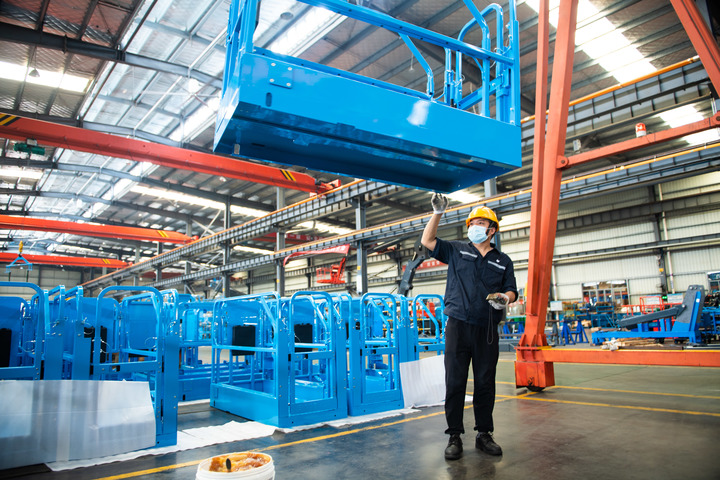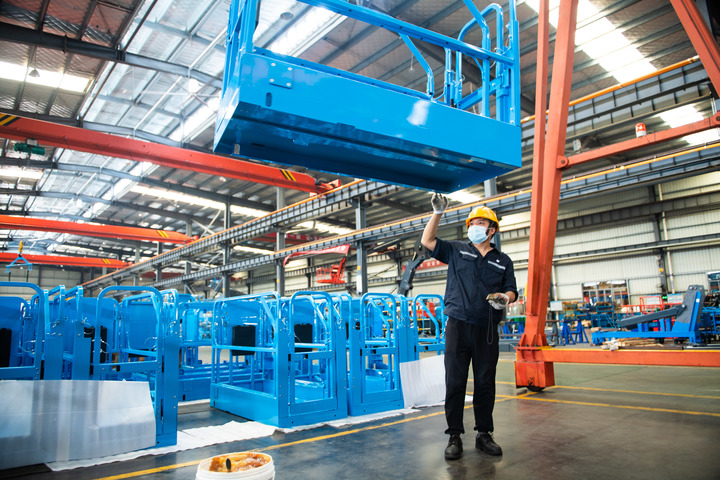
A staff member works at a workshop of a company in Ningxiang, Changsha, central China's Hunan Province, Aug. 3, 2021. (Xinhua/Chen Sihan)
BEIJING, Aug. 19 (Xinhua) -- As China ushers in the second half of the first year of the 14th Five-Year Plan period (2021-2025), its national economy has continued to recover steadily, reported the Xinhua-run Economic Information Daily on Tuesday.
Economic statistics released by the National Bureau of Statistics (NBS) on August 16 showed that though some indicators grew at a slower pace in July, key macro indicators stayed within a reasonable range on accumulative basis.
Insiders pointed out that China will remain its focus on improving cross-cycle policy adjustment, tapping the potential of the domestic market, strengthening technological innovation and the resilience of industry chains and supply chains. In the second half of the year, China is expected to maintain stable economic growth and further boost its development quality.
-- Major economic indicators still within proper range
In July, greater external uncertainties as well as COVID-19 resurgence and summer floods in China led to slower growth rates of some economic indicators. On a cumulative basis, however, major macro indicators stayed within a reasonable range, said the National Bureau of Statistics (NBS) spokesperson Fu Linghui at a press conference.
China's industrial production grow steadily last month, with strong growth momentum in the high-tech manufacturing industry. The total added value of industrial enterprises above designated size grew by 6.4 percent year on year in July, a decline of 1.9 percentage points from June but higher than that in the same period in 2019 and 2020. For the first seven months of the year, the added value of industrial enterprises above designated size increased by 14.4 percent year on year, with an average two-year growth of 6.7 percent.
The total retail sales of consumer goods in July increased by 8.5 percent year on year, 3.6 percentage points lower than that in June but higher than that in the same period in 2019 and 2020. For the first seven months of the year, total retail sales of consumer goods rose by 20.7 percent year on year, with an average two-year growth of 4.3 percent.
Fixed asset investment (FAI) was generally stable and growth in manufacturing investment quickened the pace. From January to July, China's fixed-asset investment (FAI) (excluding rural households) increased by 10.3 percent year on year, 2.3 percentage points lower than that in the first six months, with an average two-year growth of 4.3 percent.
In July, the total value of merchandise imports and exports rose by 11.5 percent year on year. In the first seven months of 2021, the total value of merchandise imports and exports registered an increase of 24.5 percent year on year, with an average two-year growth of 10.6 percent.
Meanwhile, innovative development became more resilient. From January to July, the added value of high-tech manufacturing grew by 21.5 percent year on year, with an average two-year growth of 13.1 percent. Investment in high-tech industries continued to grow rapidly, up 20.7 percent year on year, with an average two-year growth of 14.2 percent. The production of new energy vehicles and industrial robots posted year-on-year growth rates of 194.9 percent and 64.6 percent, respectively, and online retail sales of physical goods grew by 17.6 percent year on year.
On the whole, growth in industrial production has slowed down, with the exception of high-tech industries which maintained sound growth, said Tang Jianwei, chief researcher at the Bank of Communications' Financial Research Center, adding that though the services sector and consumer spending were affected by sporadic COVID-19 outbreaks and extreme weather events, investment in manufacturing enjoyed fast growth.
Wen Bin, chief researcher at China Minsheng Bank, believed that manufacturing investment sped up on robust external demand, which helped China's exports sustain rapid growth. Meanwhile, China introduced a slew of policies favorable to the manufacturing sector as well as small and medium-sized enterprises, expediting the improvement in the manufacturing sector.
-- Targeted policy mix
It is worth noting that China's economic recovery remains unstable and patchy in the face of an evolving pandemic worldwide, as well as a more complex and challenging external environment.
According to Fu, the growth rate of some consumption segments and the service sector moderated in July. Total retail sales of consumer goods grew at a slower pace compared to the previous month in some regions such as Henan, Jiangsu, Hunan, etc.
Insiders believed improving cross-cycle policy adjustment, implementing macro policies scientifically and precisely, accelerating reform and innovation, promoting transformation and upgrading, ensuring that the economy is performing within a reasonable range, and advancing high-quality economic development would be China's top priorities.
China would maintain the continuity, stability and sustainability of macro policies and improve its cross-cycle adjustment and meanwhile, make sure that the economy is performing within a reasonable range. It will enhance the efficacy of active fiscal policies, ensure reasonable and adequate liquidity under prudent monetary policies. It will unleash the potential of the domestic market, strengthen technological innovation and the resilience of industry chains and supply chains, deepen reform and opening up, prevent and address the risks in key areas, and ensure people's livelihood, Fu stressed.
Wen pointed out that it was important to improve cross-cycle policy adjustment and policy alignment. China needs to continue boosting domestic demand, further explore consumer spending growth poles, moderately accelerate the issuance of special local government bonds, speed up the construction of major construction projects, and give play to the stabilizing effect of infrastructure investment on investment and growth.
Meanwhile, China must further increase its structural support for key sectors and vulnerable segments, such as manufacturing, micro, small and medium-sized enterprises, technological innovation, inclusive finance and green finance, and boost the confidence of market players.
The key macro policy priorities in the second half of the year is to improve cross-cycle policy adjustment for 2021 and 2022, said Tang, adding that the issuance of special bonds and fiscal expenditures are expected to accelerate as there is larger room for active fiscal policies.
We shall not exclude the possibility of further broad-based or targeted reserve requirement ratio (RRR) cuts this year, Tang also noted.
--Solid economic performance ahead
Fu addressed that many factors underpin the economic recovery momentum, and numerous favorable conditions exist to promote investment, consumption, and imports and exports.
In terms of consumption, consumer spending is expected to rebound in the second half of this year on the back of rising resident income and improvement in the consumption environment. In terms of investment, construction of a number of major projects in the 14th Five-Year Plan period will commence. Manufacturing enterprises are expected to see rapid profit growth and stable business performance, which will be conducive to increasing manufacturing investment. Elsewhere, as the global economy continues to recover, improvement in the global economic and trade environment will benefit import-export growth, according to Fu.
Fu also stressed that China will further promote the new development pattern in the next phase, deepen supply-side structural reform, increase efforts in reform and innovation and boost high-quality development.(Edited by Yang Yifan with Xinhua Silk Road, yangyifan@xinhua.org)




 A single purchase
A single purchase









